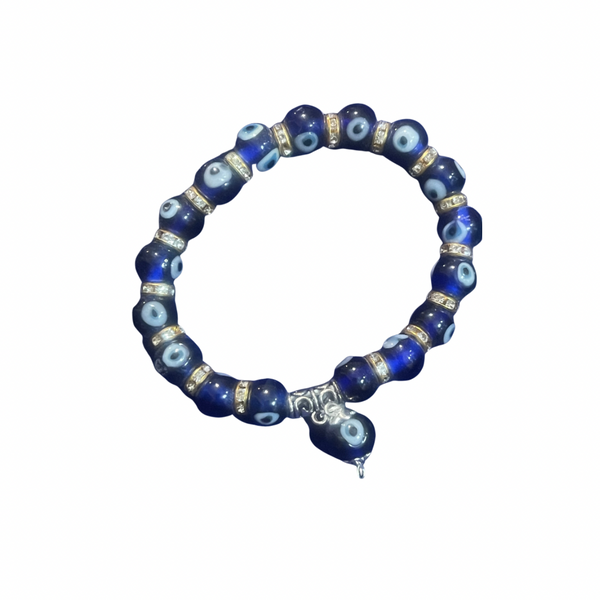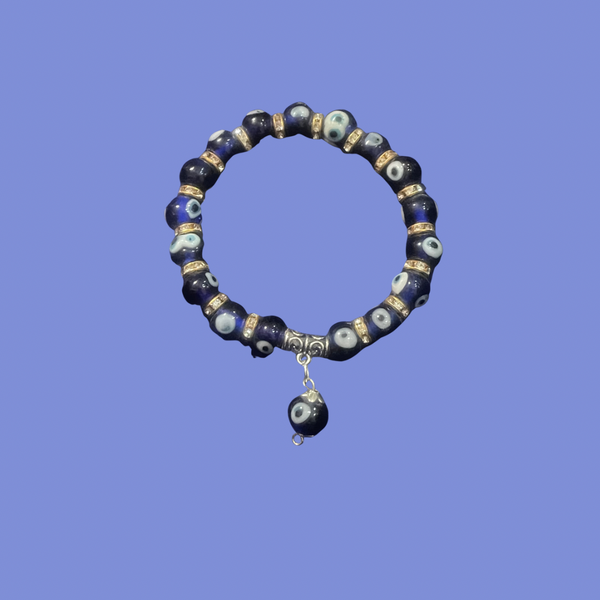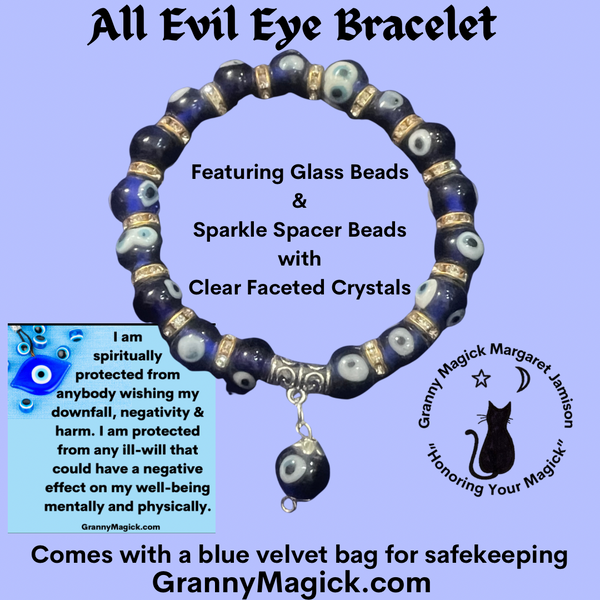All Evil Eyes Nazar Stretch Bracelet
All Evil Eyes Nazar Protection stretch elastic bracelet featutes glass beads and sparkling spacer beads with faceted crystals. Chant card included. Bracelet comes in a blue velvet pouch for safekeeping.
Nazar, also known as the Nazar Boncuk or the Evil Eye, is a talisman used to protect against the evil eye. It is commonly found in many cultures, particularly in the Mediterranean region, Middle East, and parts of Asia. Here are some uses and beliefs associated with the Nazar:
1. Protection against the Evil Eye: The Nazar is believed to protect the wearer from the negative effects of the evil eye, which is believed to bring harm, misfortune, or jealousy. It is often worn as jewelry, such as bracelets, necklaces, or pendants, to ward off the evil eye.
2. Symbol of Good Luck: The Nazar is also seen as a symbol of good luck and is believed to bring blessings and positive energy to the wearer. It is commonly used in households, cars, or workplaces as a decorative item or talisman to attract good fortune.
3. Traditional Beliefs and Practices: In some cultures, it is believed that the Nazar absorbs the negative energy or gaze of others and protects the wearer from harm. It is also believed to bring harmony, peace, and prosperity to the surrounding environment.
4. Cultural Significance: The Nazar is deeply rooted in various cultures and has become an important part of their traditions and beliefs. It is often given as a gift to newborns, newlyweds, or individuals embarking on a new journey to provide them with protection and good luck.
5. Variations in Design: The Nazar can come in various forms and designs, but it typically features a blue or turquoise-colored eye-like symbol with a dark blue or black center. The color blue is often associated with protection and is believed to repel the evil eye.
6. Modern Adaptations: In addition to traditional designs, the Nazar has also been incorporated into modern fashion and home decor. It can be found on clothing, accessories, keychains, and even decorative items like wall hangings or ornaments.
It is important to note that while the Nazar is widely believed to protect against the evil eye, its effectiveness and interpretation may vary among different cultures and individuals.
The history and symbolism of the Nazar can be traced back thousands of years and has evolved across different cultures. Here is an overview of its origins and significance:
1. Ancient Origins: The belief in the evil eye and the use of protective talismans can be traced back to ancient civilizations such as the Mesopotamians, Egyptians, Greeks, and Romans. These cultures believed that certain individuals possessed the power to inflict harm or misfortune through their envious or malevolent gaze.
2. The Eye Symbol: The central symbol of the Nazar is the eye, which is believed to represent the all-seeing eye of God or a divine power. It is also associated with the concept of protection, intuition, and spiritual insight.
3. Blue Color: The predominant color of the Nazar is blue, particularly shades of turquoise. Blue is widely associated with protection and is believed to have the power to repel negative energy and evil spirits.
4. Cultural Adaptations: As the belief in the evil eye and the use of protective talismans spread across different regions, variations in design and symbolism emerged. For example, in Turkey, the Nazar Boncuk is often depicted as a circular amulet with concentric circles of blue and white. In Greece, it is known as the Mati and features an eye-shaped amulet with shades of blue and white.
5. Symbol of Unity: The Nazar is also seen as a symbol of unity among different cultures and religions. It is used by people of various faiths, including Islam, Christianity, Judaism, and Hinduism, and is believed to transcend religious boundaries.
6. Widespread Use: The Nazar has become a popular symbol and talisman across the Mediterranean region, Middle East, and parts of Asia. It is used in various forms, including jewelry, home decor, car accessories, and even clothing.
Despite regional variations, the core symbolism of the Nazar remains consistent - protection against the evil eye, warding off negative energy, and attracting good luck and positive vibes. It is a powerful symbol of belief and faith in the power of spiritual protection.










